Forty-eight years ago this week, The Monkees’ single “I’m a Believer” was getting more airplay than any other song in the country. Thanks to 1,051,280 advance orders, it went gold within two days of its November 1966 release and spent seven weeks at the top of the charts, making it the biggest selling record of 1967. You couldn’t escape the sound. Free-form FM was still in its infancy, and most of the nation’s gargantuan cars came equipped with only an AM dial. So, even the most musically savvy flower children couldn’t escape the pop hits of the day – many of which they considered bubblegum music.
 But I was a mere child of 7, and I absolutely loved both bubblegum and pop hits! “I’m A Believer” sat stacked in my blue plastic Disk Go case along with my other favorites from 1967: “To Sir With Love,” “Georgy Girl,” “Ode to Billie Joe,” and The Mamas and the Papa’s version of “Dedicated to the One I Love” – all songs that I would sing in front of the mirror in the privacy of my bedroom, wearing go-go boots and pajamas while holding a flashlight as a microphone; all songs that I would one day butcher in karaoke parlors all over Tokyo, even without the aid of alcohol.
But I was a mere child of 7, and I absolutely loved both bubblegum and pop hits! “I’m A Believer” sat stacked in my blue plastic Disk Go case along with my other favorites from 1967: “To Sir With Love,” “Georgy Girl,” “Ode to Billie Joe,” and The Mamas and the Papa’s version of “Dedicated to the One I Love” – all songs that I would sing in front of the mirror in the privacy of my bedroom, wearing go-go boots and pajamas while holding a flashlight as a microphone; all songs that I would one day butcher in karaoke parlors all over Tokyo, even without the aid of alcohol.
By the Summer of Love I had amassed about 50 singles, all of which were subjected to heavy rotation on my little Sears Silvertone record player. I also owned nearly every Beatles’ LP released up to that point, including the most recent, “Revolver.” But while my collection included the most sophisticated Beatles album to date, it also included a lot of tame material, such as “Snoopy and His Friends, The Royal Guardsmen,” “Nancy [Sinatra] In London,” “Tom Jones Live at The Talk of The Town,” and “The Sound of Music.” I was just a kid. In fact, I was even too young to hate, on principle, the music that my parents liked. Which is why I listened to my dad’s Roger Miller album, my mom’s Louie Prima/Keely Smith LP, and my grandmother’s Engelbert Humperdinck records. Fine singers one and all. Still, it would be a few years before I discovered FM radio and the likes of The Doors, Elton John and Cream.
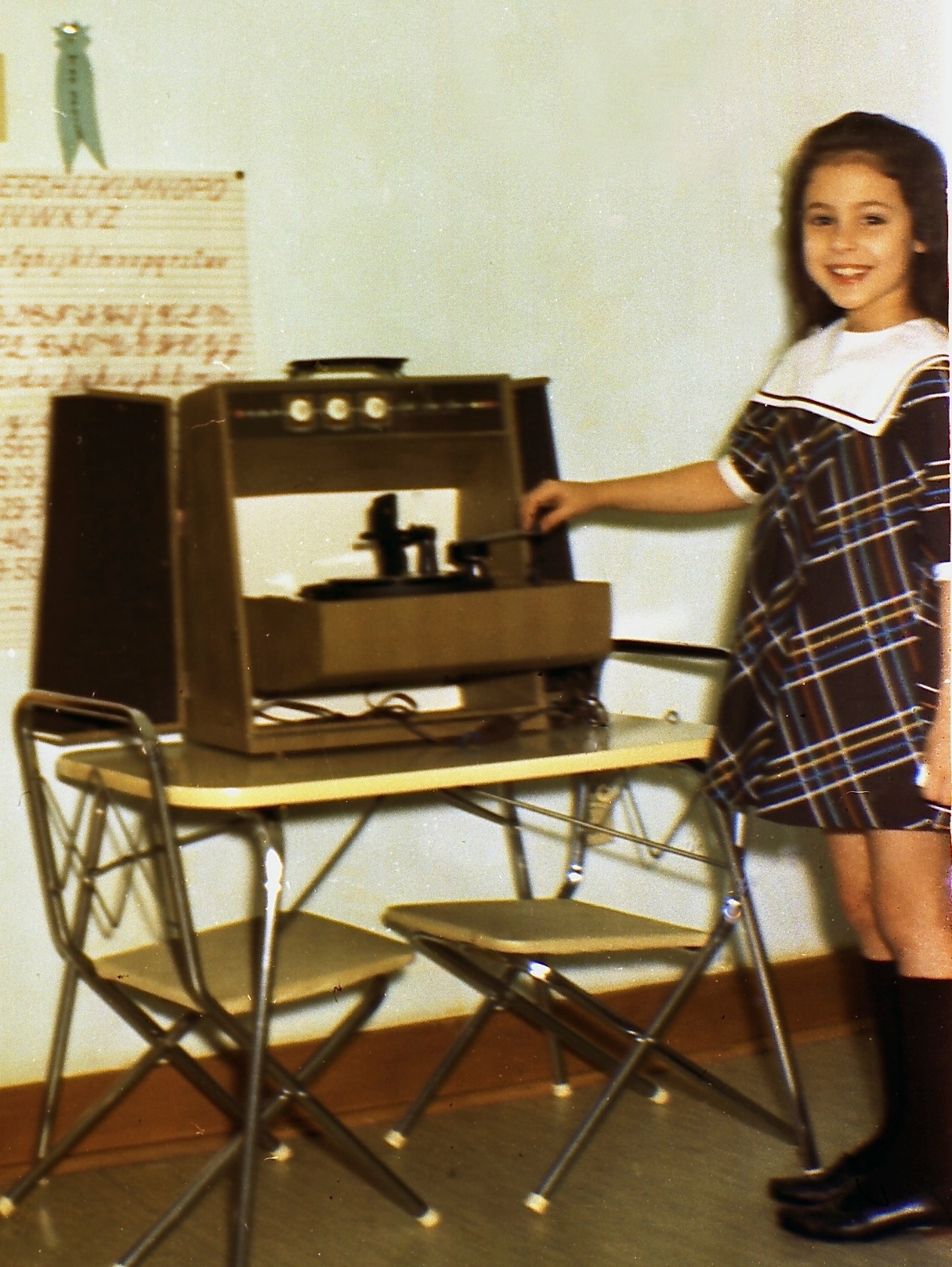 But back to 1967 and my favorite pop single of the year: “I’m a Believer.” The record remains in my collection, sitting upright on a shelf in what I pompously call my studio, its grooves ground down and its red and white Colgems label worn thin. I never bothered to download it or purchase a Monkees Greatest Hits CD. Like so many of my old vinyl gems, I preferred to digitize it, so that I can hear every flaw. It has the soothing, nostalgic sound of a log crackling on the fire. I would never have imagined that 45 years after its debut I’d get to see Micky Dolenz sing it live, with fellow Monkees Davy Jones and Peter Tork at Stage AE in Pittsburgh on a warm summer night in 2011. Micky and Davy shared lead vocal duties on all Monkees’ songs, but the band members were not permitted to play any instruments on their records at that time – much to their consternation. The Monkees were a made-for-TV band, and while the boys had varying degrees of musical talent, the producers of their show felt they weren’t seasoned enough musicians for prime time.
But back to 1967 and my favorite pop single of the year: “I’m a Believer.” The record remains in my collection, sitting upright on a shelf in what I pompously call my studio, its grooves ground down and its red and white Colgems label worn thin. I never bothered to download it or purchase a Monkees Greatest Hits CD. Like so many of my old vinyl gems, I preferred to digitize it, so that I can hear every flaw. It has the soothing, nostalgic sound of a log crackling on the fire. I would never have imagined that 45 years after its debut I’d get to see Micky Dolenz sing it live, with fellow Monkees Davy Jones and Peter Tork at Stage AE in Pittsburgh on a warm summer night in 2011. Micky and Davy shared lead vocal duties on all Monkees’ songs, but the band members were not permitted to play any instruments on their records at that time – much to their consternation. The Monkees were a made-for-TV band, and while the boys had varying degrees of musical talent, the producers of their show felt they weren’t seasoned enough musicians for prime time.
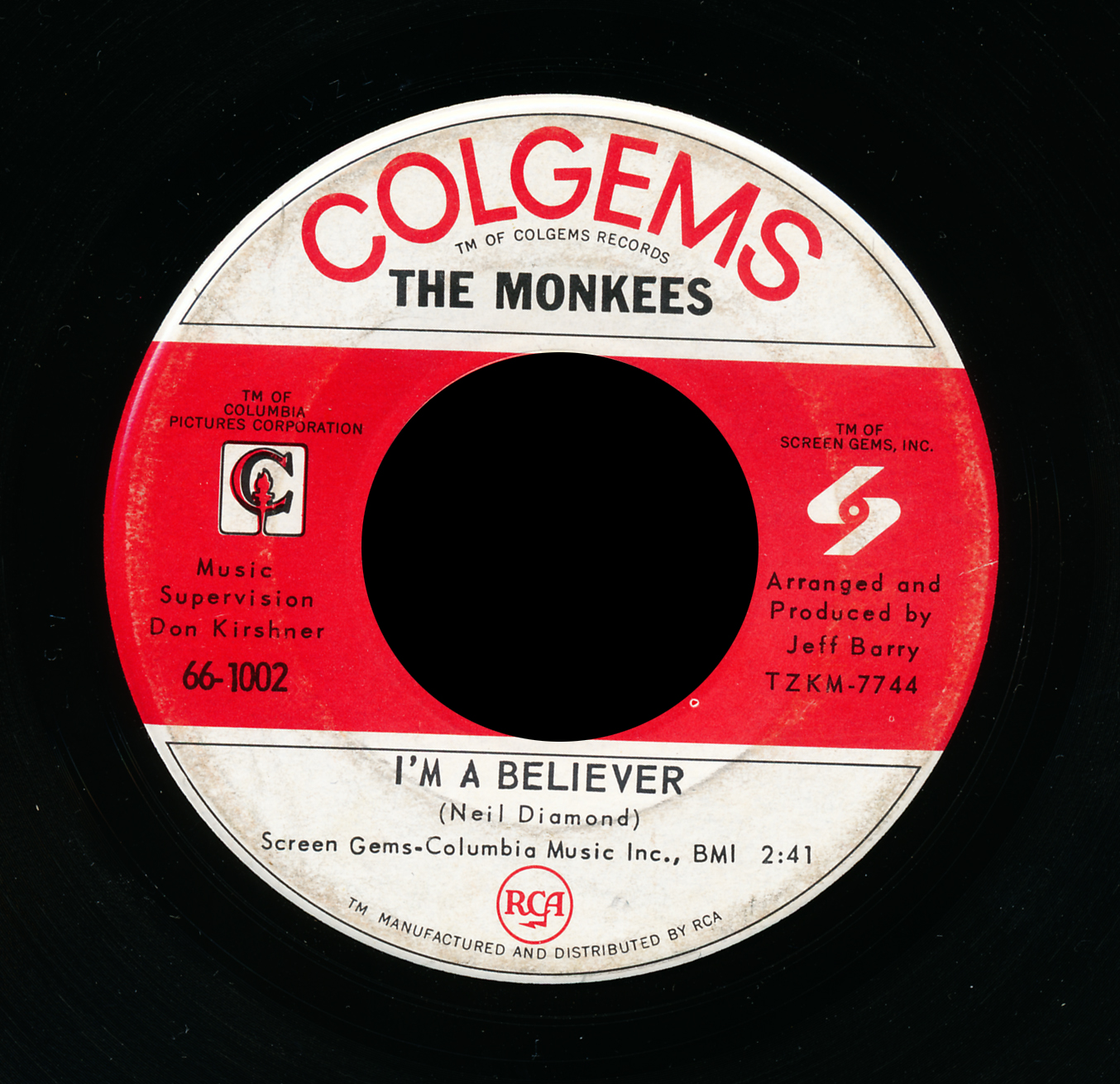 “I’m a Believer” was written by Neil Diamond, a young singer/songwriter who had recently scored a hit with “Cherry, Cherry.” The song caught the attention of producer Don Kirshner (yes, the teleprompter-reading master of late-night TV rock concert fame), who wanted his Monkees to record a tune with a similar catchy beat. He contacted Neil’s producers, Jeff Berry and Ellie Greenwich, who played Kirshner some cuts that were planned for their client’s upcoming album, “Just for You.” It’s rumored that Diamond had wanted to pitch “Believer” to country singer Eddy Arnold. But it was snatched up by the powerful Kirshner, who “allowed” Neil to record it on his own album that year. Monkee Mike Nesmith felt the song was weak and would never be a hit, but history proved him wrong.
“I’m a Believer” was written by Neil Diamond, a young singer/songwriter who had recently scored a hit with “Cherry, Cherry.” The song caught the attention of producer Don Kirshner (yes, the teleprompter-reading master of late-night TV rock concert fame), who wanted his Monkees to record a tune with a similar catchy beat. He contacted Neil’s producers, Jeff Berry and Ellie Greenwich, who played Kirshner some cuts that were planned for their client’s upcoming album, “Just for You.” It’s rumored that Diamond had wanted to pitch “Believer” to country singer Eddy Arnold. But it was snatched up by the powerful Kirshner, who “allowed” Neil to record it on his own album that year. Monkee Mike Nesmith felt the song was weak and would never be a hit, but history proved him wrong.
“I’m a Believer” is one of only thirty singles in history to have sold 10 million or more copies worldwide. And the record’s B side, “(I’m Not Your) Steppin’ Stone,” written by Tommy Boyce and Bobby Hart, is pretty damn good, too. Some might even say it’s better. Its menacing tune and accusatory lyrics make it the perfect antithesis to “Believer” in both sound and subject matter. No wonder it was a favorite of punk bands like the Sex Pistols, Cardboard Brains, Johnny Thunders, and Vicious White Kids.
Here are the Monkees “performing” their immortal hit. Micky Dolenz, always my favorite, sings the tune, but all are miming on their instruments. I love those double-breasted shirts they wore. It gave them “a look,” much as the collarless jackets did for The Beatles.
Here’s the B side of “Believer” – “(I’m Not Your) Steppin’ Stone,” performed by those dirty sods, The Sex Pistols:
By Dana Spiardi, Jan 20, 2015
]]>
 The son of Hollywood actors George and Janelle Dolenz, Micky began his career in 1956 as a bleached-blond child star in the TV show “Circus Boy” and went on to perform with a number of unsuccessful LA-area bands, including Micky and the One Nighters and The Missing Link. In 1966 he was cast as the drummer (a mimed performance) and authentic lead singer for the made-for-TV band The Monkees, singing some of the group’s biggest hits, including “I’m A Believer,” “Last Train to Clarksville” and “Pleasant Valley Sunday.” Fellow Monkee Mike Nesmith once said that Micky’s vocal styling gave the group its distinctive sound.
The son of Hollywood actors George and Janelle Dolenz, Micky began his career in 1956 as a bleached-blond child star in the TV show “Circus Boy” and went on to perform with a number of unsuccessful LA-area bands, including Micky and the One Nighters and The Missing Link. In 1966 he was cast as the drummer (a mimed performance) and authentic lead singer for the made-for-TV band The Monkees, singing some of the group’s biggest hits, including “I’m A Believer,” “Last Train to Clarksville” and “Pleasant Valley Sunday.” Fellow Monkee Mike Nesmith once said that Micky’s vocal styling gave the group its distinctive sound.
When The Monkees finally won the battle to play their own instruments live, he learned percussion and became a bona fide beater on the band’s later LPs. And who says the boys weren’t cutting edge? Micky was the third person ever to own a Moog synthesizer (right behind recording engineer and musician Wendy Carlos and country music star Buck Owens). Micky’s Moog was among the first to be used in a pop/rock recording: the Monkees’ song “Daily Nightly” from their 1967 LP “Pisces, Aquarius, Capricorn & Jones Ltd.” (A few months earlier the Doors had employed a Moog in the production of their “Strange Days” album.)
As a child I pondered a great mystery: why was Micky’s hair straight in the first season of show and forever curly after that? Using a technique that only contrary-haired people like myself understand, he started out forcing his hair into submission by brushing it hard while damp until it dried into a sleek heap that would make Vidal Sassoon proud. By the second season, the hippie-inspired “let it all hang out” movement was in full swing, so Micky decided to let his curls run amok and cop the popular Afro look. Another childhood puzzle solved!
At the height of Monkeemania, Micky received a draft notice but was dismissed because he was underweight and physically challenged. A childhood condition known as Perthese disease left him with one leg shorter than the other. Micky quipped that the Army told him, “Don’t worry, we’ll only make you fight on hillsides.”
By the late 1960s the Monkees’ shine had faded, but Micky always had the talent to find work. He relocated to London and directed for theater and television. He provided voice-overs for hundreds of Saturday morning cartoon shows, including the “Funky Phantom” and “Scooby Doo.” He even auditioned for the role of The Fonz in the TV show “Happy Days” but lost out to Henry Winkler. In 2005 he enjoyed a brief stint as the morning DJ at WCBS in New York.
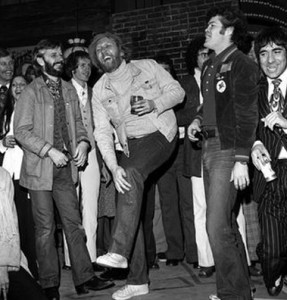 Through the years he’s toured on and off with fellow Monkees and with Tommy Boyce and Bobby Hart, who penned many of the Monkees’ hits. Micky, Davy and Peter Tork were still going strong in 2011, when I had the chance to see them live in Pittsburgh. My heart melted when the concert commenced with the opening organ chords to “I’m a Believer,” sung by the now pudgy-faced Micky, looking ultra sharp in black jeans, black vest and black fedora.
Through the years he’s toured on and off with fellow Monkees and with Tommy Boyce and Bobby Hart, who penned many of the Monkees’ hits. Micky, Davy and Peter Tork were still going strong in 2011, when I had the chance to see them live in Pittsburgh. My heart melted when the concert commenced with the opening organ chords to “I’m a Believer,” sung by the now pudgy-faced Micky, looking ultra sharp in black jeans, black vest and black fedora.
Some of Micky’s most interesting career collaborations were of a more social nature. By the mid-1970s he had become a member of an inner circle of inebriate rock celebrities that included Ringo Starr, John Lennon, Harry Nilsson, and Keith Moon. Raconteur supremo Micky loves to share interesting tales of endless West Coast party days and nights spent with the very rockers that he and his Monkees bandmates were considered inferior to. He’s one of the few survivors of this band of talented artists.
Micky, you were one of my earliest crush objects. Thanks for five decades of wonderful Monkee business.
Here’s the jivin’, scattin’, James Brown-shufflin’ Micky in an incredibly hip day-glo clip from 1967.The quality is poor, but it shows him at his best. All four Monkees share writing credits for this song.
© Dana Spiardi, March 8, 2012
]]>
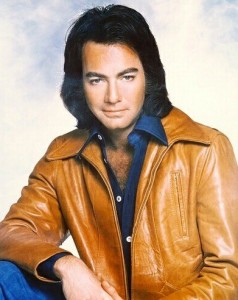 He’s best known for the ubiquitous “Sweet Caroline,” a composition based on his memory of a Life magazine cover photo of young Caroline Kennedy, decked in riding regalia, sitting atop a horse. The homage was a charming gesture, in an era when most rockers were penning acid-tinged odes to maharishis and drug doctors. While the song only reached #4 on the charts, it later went on to platinum status and would one day be heard in sports stadiums across the land. Boston Red Sox fans are just plain Caroline-crazy, singing along to the tune during the eighth inning of every home game. Other teams have embraced the song, as well, from the New York Mets and Washington Nationals to the New York Rangers and Pitt Panthers. One of life’s great mysteries remains: What’s the connection between Caroline and cleats?
He’s best known for the ubiquitous “Sweet Caroline,” a composition based on his memory of a Life magazine cover photo of young Caroline Kennedy, decked in riding regalia, sitting atop a horse. The homage was a charming gesture, in an era when most rockers were penning acid-tinged odes to maharishis and drug doctors. While the song only reached #4 on the charts, it later went on to platinum status and would one day be heard in sports stadiums across the land. Boston Red Sox fans are just plain Caroline-crazy, singing along to the tune during the eighth inning of every home game. Other teams have embraced the song, as well, from the New York Mets and Washington Nationals to the New York Rangers and Pitt Panthers. One of life’s great mysteries remains: What’s the connection between Caroline and cleats?
After turning out nearly 40 albums and 56 singles over the past 50 years, Neil Diamond was finally inducted into the Rock and Roll Hall of Fame in 2011. In introducing his friend, Paul Simon said, “My question is: what took so long? I’ll give you my theory. Six words: ‘You Don’t Bring Me Flowers Anymore.'” Okay, so Neil has gone down schmaltzy streets from time to time (so have born-rockers Rod Stewart and Elvis Costello), but you can’t deny the brilliance of his writing and beauty of his voice.
 Neil Diamond is sometimes referred to as the Jewish Elvis. It’s an interesting comparison, if you don’t count the King’s diet (fried peanut butter and banana sandwiches), wardrobe (bursting-at-the-seams jumpsuits), and hobbies (using TV screens for target practice).
Neil Diamond is sometimes referred to as the Jewish Elvis. It’s an interesting comparison, if you don’t count the King’s diet (fried peanut butter and banana sandwiches), wardrobe (bursting-at-the-seams jumpsuits), and hobbies (using TV screens for target practice).
Still, both Elvis and Neil were graced with dark good looks, powerful voices and a passion for performing. But according to the “Jew or Not Jew” website, which rates Jewishness on a scale of 1 to 10, Neil falls short as a true-blue Jew: “It has everything to do with his Christmas album. That’s right, a supposed observant Jew released something called ‘The Christmas Album.’ How does that make any sense? Why did you do that, Neil?”
Hey, he’s Neil Diamond and he’s earned the right to make whatever musical noise he wants. He is…he said.
Here’s Neil, playing “Cherry, Cherry,” a great little rock-n-roll tune.
© Dana Spiardi, Jan 24, 2012
]]> Felix started the night with a lively set of the Rascals hits, such as Groovin’, I’ve Been Lonely Too Long, People Got to Be Free – and the big hit – Good Lovin’. He engaged the audience in some spirited singalongs and managed to hit all the notes at the age on 66. I was wondering if the E Street Band’s Steven Van Zandt might make a surprise appearance. After all, he’s the man who helped induct the Rascals into the Rock-n-Roll Hall of Fame with a hilarious speech that caught the attention of producer David Chase and landed him a role on HBO’s The Sopranos. Well, no Steven, but a great set nonetheless.
Felix started the night with a lively set of the Rascals hits, such as Groovin’, I’ve Been Lonely Too Long, People Got to Be Free – and the big hit – Good Lovin’. He engaged the audience in some spirited singalongs and managed to hit all the notes at the age on 66. I was wondering if the E Street Band’s Steven Van Zandt might make a surprise appearance. After all, he’s the man who helped induct the Rascals into the Rock-n-Roll Hall of Fame with a hilarious speech that caught the attention of producer David Chase and landed him a role on HBO’s The Sopranos. Well, no Steven, but a great set nonetheless.
Next came the headliner, 64-year-old Tommy James, sporting a most unusual hairdo: a combination mullet AND comb-over! He hit the stage to the heavy bass of Draggin’ the Line and proceeded to belt out all of his major hits with an abundance of energy. He sounded great and the musicians played their axes at loud volume. We had perfect seats – four rows from the stage. In the middle of Mony Mony – my all-time favorite dance song — Tommy came down from the stage to mingle with crowd and shake hands, but I couldn‘t manage to get out of my row without climbing all over the hefty seniors with cotton in their ears and pillows under their butts.
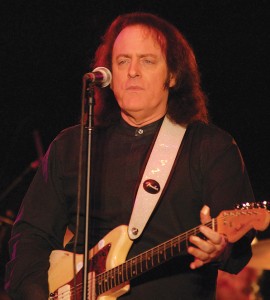 I think this was my favorite concert of the year. Sure, it didn’t have the grandeur of Sir Elton John’s concert, the nostalgia of the Monkees show, or the hipness of Elvis Costello’s gig, but it was a true feelgood experience. And so what if the words are repetitive and don’t make sense? What is crystal blue persuasion, anyway? Why did he have to show her that crimson and clover – over and over? And what the heck does MONY mean? (it’s actually a reference to the Mutual of New York sign, just like in Midnight Cowboy!).
I think this was my favorite concert of the year. Sure, it didn’t have the grandeur of Sir Elton John’s concert, the nostalgia of the Monkees show, or the hipness of Elvis Costello’s gig, but it was a true feelgood experience. And so what if the words are repetitive and don’t make sense? What is crystal blue persuasion, anyway? Why did he have to show her that crimson and clover – over and over? And what the heck does MONY mean? (it’s actually a reference to the Mutual of New York sign, just like in Midnight Cowboy!).
The Michigan-reared Tommy James got his start when a Pittsburgh promoter picked up a record called Hanky Panky (penned by Jeff Barry and Ellie Greenwich!) in a bargain big and started playing it in local dance clubs. Soon, a bootlegger pressed copies and sold it in the area, and it became a huge hit on Pittsburgh radio stations in 1966. In fact, the Shondell lineup of the 1960s was made up of musicians from Pittsburgh.
Sure, it’s not world-changing rock. But these are the songs from my teenybopper years that cause me to crank up the volume every time I hear them.
Here’s Tommy and the boys grooving to Mony Mony in the 60s. I love Tommy’s Nehru jacket!
© Dana Spiardi, July 24, 2011
]]>